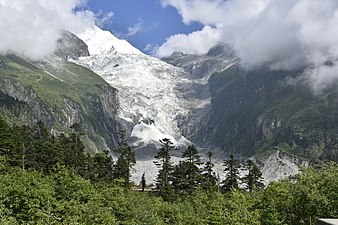
Sichuan
Sichuan[a] is a province in Southwestern China occupying the Sichuan Basin and Tibetan Plateau between the Jinsha River on the west, the Daba Mountains in the north and the Yungui Plateau to the south. Sichuan's capital city is Chengdu; its population stands at 83 million. Sichuan neighbors Qinghai to the northwest, Gansu to the north, Shaanxi to the northeast, Chongqing (historically part of Sichuan) to the east, Guizhou to the southeast, Yunnan to the south, and Tibet to the west.
Sichuan
四川
四川省 (Sìchuān Shěng)
21 prefectures, 181, 5011
Wang Xiaohui
147 deputies
485,000 km2 (187,000 sq mi)
7,556 m (24,790 ft)
83,674,866
170/km2 (450/sq mi)
CN¥ 67,777
US$ 10,077
CN-SC
Szechwan
"Four Plains"[5]
Sìchuān
Sìchuān
ㄙˋ ㄔㄨㄢ
Syhchuan
Ssŭ4-chʻuan1
Sz̀-chwān
Si4-cuan1
Sy3-tshoe1
Si-tshôn
Sei-chyūn
Sei3-cyun1
Sù-chhoan
Sì-tshuan
སི་ཁྲོན་
si khron
si khron
Sichoin
ꌧꍧ
syp chuo
Bāshǔ
Bāshǔ
ㄅㄚ ㄕㄨˇ
Bashuu
Pa1-shu3
In antiquity, Sichuan was home to the kingdoms of ancient state of Ba and Shu until their incorporation by the Qin. During the Three Kingdoms era, Liu Bei's state of Shu was based in Sichuan. The area was devastated in the 17th century by Zhang Xianzhong's rebellion and the area's subsequent Manchu conquest, but recovered to become one of China's most productive areas by the 19th century. During World War II, Chongqing served as the temporary capital of the Republic of China, and was thus heavily bombed. It was one of the last mainland areas captured by the People's Liberation Army during the Chinese Civil War, and was divided into four parts from 1949 to 1952, with Chongqing restored two years later. It suffered gravely during the Great Chinese Famine of 1959–61 but remained China's most populous province until Chongqing Municipality was again separated from it in 1997.
The Han Chinese people of Sichuan speak distinctive Sichuanese dialects of Mandarin Chinese. The spicy Sichuan pepper is prominent in modern Sichuan cuisine, featuring dishes—including Kung Pao chicken and mapo tofu—that have become staples of Chinese cuisine around the world.
Sichuan is the 6th-largest provincial economy of China, the largest in Western China and the second largest among inland provinces after Henan. As of 2021, its nominal GDP was 5,385 billion yuan (US$847.68 billion), ahead of the GDP of Turkey of 815 billion.[7][8] Compared to a country, it would be the 18th-largest economy as well as the 19th most populous as of 2021.[9]
There are many panda stations in the province and large reserves for these creatures, such as the Chengdu Research Base of Giant Panda Breeding.
Names[edit]
It is commonly believed that the name Sichuan means "four rivers"; in folk etymology, this is usually taken to mean four of the province's major rivers: the Jialing, Jinsha (or Wu), Min, and Tuo.[10][11] According to historical geographer Tan Qixiang, "four rivers" is an erroneous interpretation of the place's name.[12] The name of the province is a contraction of the phrases Sì Chuānlù (四川路, "Four Plain Circuits") and Chuānxiá Sìlù (川峽四路, "Four Circuits of Chuanxia"),[note 1][13] referring to the division of the existing imperial administrative circuit in the area into four during the Northern Song dynasty, which were Yizhou, Lizhou, Zizhou, and Kuizhou.[14] The word chuan (川) here means "plain", not its normal meaning of "river" as popularly assumed.[15][16] In addition to its postal map and Wade-Giles forms, the name has also been irregularly romanized as Szű-chuan and Szechuen.
In antiquity, the area of modern Sichuan including the now separated Chongqing Municipality was known to the Chinese as Ba-Shu, in reference to the ancient state of Ba and the ancient kingdom of Shu that once occupied the Sichuan Basin. Shu continued to be used to refer to the Sichuan region all through its history right up to the present day; several states formed in the area used the same name, for example, the Shu of the Three Kingdoms period, and Former Shu and Later Shu of the Ten Kingdoms period.[17] Currently, both the characters for Shu and Chuan are commonly used as abbreviations for Sichuan.[18]
The region was formerly also referred to as "West China" or "Western China" by Protestant missions.
History[edit]
Prehistory[edit]
The Sichuan Basin and adjacent areas of the Yangtze watershed were a cradle of indigenous civilizations dating back to at least the 15th century BC, coinciding with the Shang in northern China. The region had its own distinct religious beliefs and worldview. The earliest excavated culture found therein is the Baodun culture (c.2700–1750 BC) excavated in the Chengdu Plain.[19][20]
UNESCO World Heritage Sites in Sichuan province and Chongqing municipality include:
As of July 2013, the world's largest building, the New Century Global Center is located in Chengdu. At 328 ft (100 m) high, 1,640 ft (500 m) long, and 1,312 ft (400 m) wide, the Center houses retail outlets, movie theaters, offices, hotels, the Paradise Island waterpark, an artificial beach, a 164 yd (150 m)-long LED screen, skating rink, pirate ship, fake Mediterranean village, 24-hour artificial sun, and 15,000-spot parking area.[108]
Visa exemption[edit]
144-hour Visa-free Transit[edit]
Holders of passports issued by 53 countries do not require a visa for a 144-hour stay if they are transiting through Chengdu Tianfu International Airport and Chengdu Shuangliu International Airport of entry, provided that they:[109][110]
Professional sports teams in Sichuan include:








![Baba Mosque [zh], a Chinese Sufi mosque in Langzhong.](http://upload.wikimedia.org/wikipedia/commons/thumb/1/1f/%E5%B7%B4%E5%B7%B4%E5%AF%BA.JPG/120px-%E5%B7%B4%E5%B7%B4%E5%AF%BA.JPG)














